In video games, a power-up is an object that adds temporary benefits or extra abilities to the player character as a game mechanic. This is in contrast to an item, which may or may not have a permanent benefit that can be used at any time chosen by the player. Although often collected directly through touch, power-ups can sometimes only be gained by collecting several related items, such as the floating letters of the word 'EXTEND' in Bubble Bobble. Well known examples of power-ups that have entered popular culture include the power pellets from Pac-Man and the Super Mushroom from Super Mario Bros., which ranked first in UGO Networks' Top 11 Video Game Powerups.

Super Street Fighter II: The New Challengers is a competitive fighting game produced by Capcom and originally released as an arcade game in 1993. It is the fourth game in the Street Fighter II sub-series of Street Fighter games, following Street Fighter II: Hyper Fighting. It refines and balances the existing character roster from the previous versions, and introduces four new characters. It is the first game on Capcom's CP System II hardware, with more sophisticated graphics and audio over the original CP System hardware used in previous versions of Street Fighter II.

Sunset Riders is a side-scrolling run and gun video game developed and released by Konami as an arcade video game in 1991. It is set in the American Old West, where the player takes control of a bounty hunter who is seeking the rewards offered for various criminals.
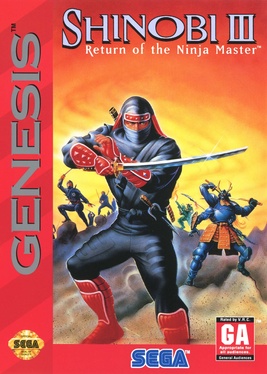
Shinobi III: Return of the Ninja Master, released in Japan as The Super Shinobi II, is a 1993 hack-and-slash platform game developed and published by Sega for the Mega Drive/Genesis. It is the direct sequel to the previous The Revenge of Shinobi. The game was intended to be released in 1992 and to be very different from the final version of the game in terms of levels and storyline.
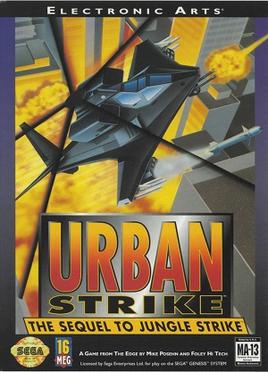
Urban Strike is a video game developed and published by Electronic Arts. It was initially released for the Sega Genesis in 1994, with ports handled by Black Pearl Software to the Super Nintendo Entertainment System and Game Gear in 1995 and to the Game Boy in 1996. It is the third game in the Strike series, after Desert Strike: Return to the Gulf and Jungle Strike.

Captain America and the Avengers is a beat 'em up arcade game developed and released by Data East in 1991. It features the Avengers team of Marvel Comics characters in a side-scrolling brawling and shooting adventure to defeat the evil Red Skull. The game received ports for the Sega Genesis/Mega Drive, Super Nintendo Entertainment System, Game Boy and Game Gear. A different Data East game was released for the Nintendo Entertainment System.

Jungle Strike is a video game developed and published by Electronic Arts in 1993 for the Sega Genesis/Mega Drive. The game was later released on several other consoles such as the Super Nintendo Entertainment System (SNES), and an upgraded version was made for DOS computers. The Amiga conversion was the responsibility of Ocean Software while the SNES and PC DOS versions were that of Gremlin Interactive, and the portable console versions were of Black Pearl Software. It is the direct sequel to Desert Strike and is the second installment in the Strike series. The game is a helicopter-based shoot 'em up, mixing action and strategy. The plot concerns two villains intent on destroying Washington, D.C. The player must use the helicopter and occasionally other vehicles to thwart their plans.

The Genesis, also known as the Mega Drive outside North America, is a 16-bit fourth generation home video game console developed and sold by Sega. It was Sega's third console and the successor to the Master System. Sega released it in 1988 in Japan as the Mega Drive, and in 1989 in North America as the Genesis. In 1990, it was distributed as the Mega Drive by Virgin Mastertronic in Europe, Ozisoft in Australasia, and Tectoy in Brazil. In South Korea, it was distributed by Samsung Electronics as the Super Gam*Boy and later the Super Aladdin Boy.

Terminator 2: Judgment Day or T2 is a light gun shooter based on the film of the same name, produced by Midway Manufacturing Company as an arcade video game in 1991. Developed in tandem with the movie, several actors from the film reprise their roles for the game and are featured as part of the game's photorealistic digitized graphics. The game's plot largely follows that of the film, casting up to two players as the T-800 "terminator" cyborg from the film, sent back in time to protect John Connor from assassination by the T-1000 terminator. A success in arcades, home conversions of the game were released by Acclaim Entertainment for various platforms under the title of T2: The Arcade Game in order to avoid confusion with the numerous tie-in games also based on the movie.

Gaiares is a horizontally scrolling shooter developed by Telenet Japan and published by Renovation for the Sega Genesis in Japan and North America in 1990. It was one of the first 8Mb cartridge games on the Genesis. Its title combined Gaia and the suffix "less" (Res), as the Earth has been lost to pollution in the far future according to the game's plot.
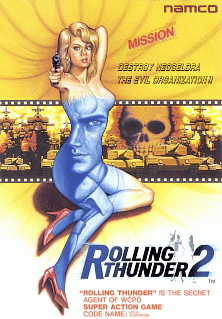
Rolling Thunder 2 is a run and gun arcade game developed and released by Namco for the Namco System 2 hardware in 1991. The game is the sequel to 1986's Rolling Thunder, retaining the same gameplay of its predecessor but adding cooperative gameplay for two players and improved graphics. Unlike the original, which was based in 1968, Rolling Thunder 2 has a more contemporary setting to go with its more futuristic design, as well as an optionally playable female character. A port for the Sega Genesis was released the same year. Both the Mega Drive port and the original arcade game were released for the Wii Virtual Console on December 4, 2007 and October 27, 2009 respectively.

Mad Max is a post-apocalyptic action game developed by Canadian studio Gray Matter and published by Mindscape for the Nintendo Entertainment System in 1990. The game is based on the 1981 Australian film Mad Max 2. The game is a remake of Road Raider.
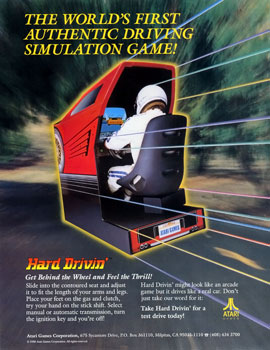
Hard Drivin' is a sim racing arcade video game developed by Atari Games in 1989. It invites players to test drive a sports car on courses that emphasize stunts and speed. It features one of the first 3D polygon driving environments via a simulator cabinet with a force feedback steering wheel and a custom rendering architecture.

The Death and Return of Superman is a side-scrolling beat 'em up video game released by Sunsoft for the Super NES and Genesis in 1994. It is based on "The Death of Superman" comic book storyline by DC Comics and features many characters from the comics, including Superman himself, Superboy, Steel, Cyborg Superman, the Eradicator, and Doomsday. All of the five Supermen are playable characters at some point.
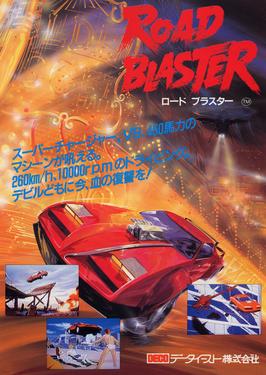
Road Blaster (ロードブラスター) is an interactive movie video game developed by Data East featuring animation by Toei Animation, originally released exclusively in Japan as a laserdisc-based arcade game in 1985. The player assumes the role of a vigilante who must avenge the death of his wife by pursuing the biker gang responsible for her death in a modified sports car. The game would later be ported to a variety of home formats such as the MSX and Sharp X1, Sega CD, LaserActive, PlayStation and Sega Saturn. The Sega CD and Mega-LD versions were released outside of Japan under titles of Road Avenger and Road Prosecutor respectively.
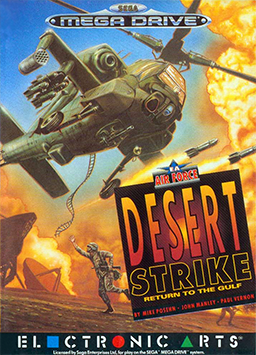
Desert Strike: Return to the Gulf is a shoot 'em up video game released by Electronic Arts (EA) in March 1992 for the Sega Genesis. The game was released on several other formats such as the Super Nintendo Entertainment System, including a much upgraded version for the Amiga home computer. The game was inspired by the Gulf War and depicts a conflict between an insane Middle Eastern dictator, General Kilbaba, and the United States. The player controls an Apache helicopter and attempts to destroy enemy weapons and installations, rescue hostages and capture enemy personnel, while managing supplies of fuel and ammunition.

Super Thunder Blade (スーパーサンダーブレード) is a combat flight simulation shooter game developed and published by Sega for the Mega Drive/Genesis console. It was one of the two launch titles for the console in Japan, as well as being one of the six launch titles for the console for its U.S. launch. It is a follow-up to the 1987 arcade game Thunder Blade.

Top Gear 2 is a racer video game developed and published by Gremlin Interactive. A direct sequel to the 1992 game Top Gear, it was first released by Kemco for the SNES in North America on August 8, 1993, and then the Super Famicom in Japan on December 22. It was later ported to the Amiga on May 24, 1994 by Gremlin Interactive, and to the Sega Genesis on June 2 by Vic Tokai. While more realistic than its predecessor, Top Gear 2 maintained the arcade-style gameplay the series is known for.

Indiana Jones' Greatest Adventures is a 1994 platform video game released for the Super Nintendo Entertainment System. It is a video game adaptation of the Indiana Jones films Raiders of the Lost Ark (1981), Indiana Jones and the Temple of Doom (1984), and Indiana Jones and the Last Crusade (1989). The game was developed by Factor 5 and published by JVC Musical Industries. The story is told through cutscenes and text and is mostly faithful to the movies. Its release coincided with that of Super Star Wars: Return of the Jedi, also released by JVC and LucasArts and in the same platform style as the Super Star Wars trilogy.

Road Rash is a 1991 racing and vehicular combat video game originally developed and published by Electronic Arts (EA) for the Sega Genesis. It was subsequently ported to a variety of contemporary systems by differing companies. The game is centered around a series of motorcycle races throughout California that the player must win to advance to higher-difficulty races, while engaging in unarmed and armed combat to hinder the other racers.



















